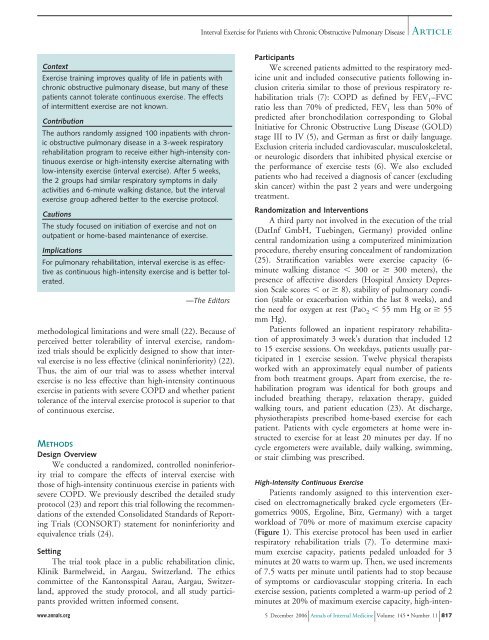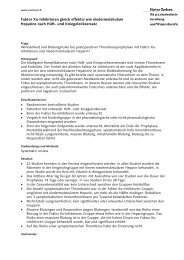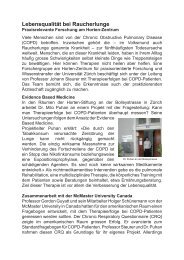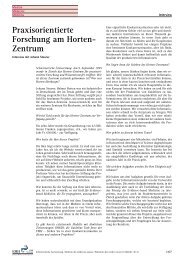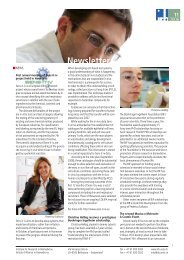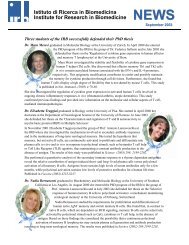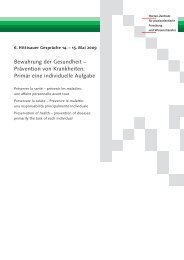Annals of Internal Medicine - Helmut Horten Stiftung
Annals of Internal Medicine - Helmut Horten Stiftung
Annals of Internal Medicine - Helmut Horten Stiftung
You also want an ePaper? Increase the reach of your titles
YUMPU automatically turns print PDFs into web optimized ePapers that Google loves.
Context<br />
Exercise training improves quality <strong>of</strong> life in patients with<br />
chronic obstructive pulmonary disease, but many <strong>of</strong> these<br />
patients cannot tolerate continuous exercise. The effects<br />
<strong>of</strong> intermittent exercise are not known.<br />
Contribution<br />
The authors randomly assigned 100 inpatients with chronic<br />
obstructive pulmonary disease in a 3-week respiratory<br />
rehabilitation program to receive either high-intensity continuous<br />
exercise or high-intensity exercise alternating with<br />
low-intensity exercise (interval exercise). After 5 weeks,<br />
the 2 groups had similar respiratory symptoms in daily<br />
activities and 6-minute walking distance, but the interval<br />
exercise group adhered better to the exercise protocol.<br />
Cautions<br />
The study focused on initiation <strong>of</strong> exercise and not on<br />
outpatient or home-based maintenance <strong>of</strong> exercise.<br />
Implications<br />
For pulmonary rehabilitation, interval exercise is as effective<br />
as continuous high-intensity exercise and is better tolerated.<br />
methodological limitations and were small (22). Because <strong>of</strong><br />
perceived better tolerability <strong>of</strong> interval exercise, randomized<br />
trials should be explicitly designed to show that interval<br />
exercise is no less effective (clinical noninferiority) (22).<br />
Thus, the aim <strong>of</strong> our trial was to assess whether interval<br />
exercise is no less effective than high-intensity continuous<br />
exercise in patients with severe COPD and whether patient<br />
tolerance <strong>of</strong> the interval exercise protocol is superior to that<br />
<strong>of</strong> continuous exercise.<br />
METHODS<br />
Design Overview<br />
We conducted a randomized, controlled noninferiority<br />
trial to compare the effects <strong>of</strong> interval exercise with<br />
those <strong>of</strong> high-intensity continuous exercise in patients with<br />
severe COPD. We previously described the detailed study<br />
protocol (23) and report this trial following the recommendations<br />
<strong>of</strong> the extended Consolidated Standards <strong>of</strong> Reporting<br />
Trials (CONSORT) statement for noninferiority and<br />
equivalence trials (24).<br />
Setting<br />
The trial took place in a public rehabilitation clinic,<br />
Klinik Barmelweid, in Aargau, Switzerland. The ethics<br />
committee <strong>of</strong> the Kantonsspital Aarau, Aargau, Switzerland,<br />
approved the study protocol, and all study participants<br />
provided written informed consent.<br />
Interval Exercise for Patients with Chronic Obstructive Pulmonary Disease<br />
—The Editors<br />
Article<br />
Participants<br />
We screened patients admitted to the respiratory medicine<br />
unit and included consecutive patients following inclusion<br />
criteria similar to those <strong>of</strong> previous respiratory rehabilitation<br />
trials (7): COPD as defined by FEV 1–FVC<br />
ratio less than 70% <strong>of</strong> predicted, FEV 1 less than 50% <strong>of</strong><br />
predicted after bronchodilation corresponding to Global<br />
Initiative for Chronic Obstructive Lung Disease (GOLD)<br />
stage III to IV (5), and German as first or daily language.<br />
Exclusion criteria included cardiovascular, musculoskeletal,<br />
or neurologic disorders that inhibited physical exercise or<br />
the performance <strong>of</strong> exercise tests (6). We also excluded<br />
patients who had received a diagnosis <strong>of</strong> cancer (excluding<br />
skin cancer) within the past 2 years and were undergoing<br />
treatment.<br />
Randomization and Interventions<br />
A third party not involved in the execution <strong>of</strong> the trial<br />
(DatInf GmbH, Tuebingen, Germany) provided online<br />
central randomization using a computerized minimization<br />
procedure, thereby ensuring concealment <strong>of</strong> randomization<br />
(25). Stratification variables were exercise capacity (6minute<br />
walking distance � 300 or � 300 meters), the<br />
presence <strong>of</strong> affective disorders (Hospital Anxiety Depression<br />
Scale scores � or � 8), stability <strong>of</strong> pulmonary condition<br />
(stable or exacerbation within the last 8 weeks), and<br />
the need for oxygen at rest (PaO 2 � 55 mm Hg or � 55<br />
mm Hg).<br />
Patients followed an inpatient respiratory rehabilitation<br />
<strong>of</strong> approximately 3 week’s duration that included 12<br />
to 15 exercise sessions. On weekdays, patients usually participated<br />
in 1 exercise session. Twelve physical therapists<br />
worked with an approximately equal number <strong>of</strong> patients<br />
from both treatment groups. Apart from exercise, the rehabilitation<br />
program was identical for both groups and<br />
included breathing therapy, relaxation therapy, guided<br />
walking tours, and patient education (23). At discharge,<br />
physiotherapists prescribed home-based exercise for each<br />
patient. Patients with cycle ergometers at home were instructed<br />
to exercise for at least 20 minutes per day. If no<br />
cycle ergometers were available, daily walking, swimming,<br />
or stair climbing was prescribed.<br />
High-Intensity Continuous Exercise<br />
Patients randomly assigned to this intervention exercised<br />
on electromagnetically braked cycle ergometers (Ergometrics<br />
900S, Ergoline, Bitz, Germany) with a target<br />
workload <strong>of</strong> 70% or more <strong>of</strong> maximum exercise capacity<br />
(Figure 1). This exercise protocol has been used in earlier<br />
respiratory rehabilitation trials (7). To determine maximum<br />
exercise capacity, patients pedaled unloaded for 3<br />
minutes at 20 watts to warm up. Then, we used increments<br />
<strong>of</strong> 7.5 watts per minute until patients had to stop because<br />
<strong>of</strong> symptoms or cardiovascular stopping criteria. In each<br />
exercise session, patients completed a warm-up period <strong>of</strong> 2<br />
minutes at 20% <strong>of</strong> maximum exercise capacity, high-inten-<br />
www.annals.org 5 December 2006 <strong>Annals</strong> <strong>of</strong> <strong>Internal</strong> <strong>Medicine</strong> Volume 145 Number 11 817


